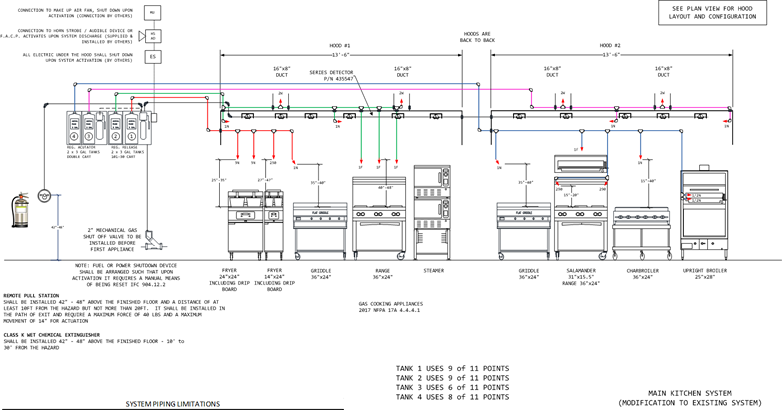
Restaurant kitchen fire suppression systems are specialized fire protection systems designed to safeguard commercial kitchens, which are at high risk of fires due to the use of cooking equipment, open flames, and flammable oils and greases.
These systems are designed to protect against fires caused by cooking appliances, exhaust hoods, and other kitchen equipment. Here are the key components and features of a restaurant kitchen fire suppression system:
- Fire Suppression Agent: Restaurant kitchen fire suppression systems commonly use a wet chemical agent, specifically designed for suppressing grease fires. This agent rapidly cools and smothers the fire to prevent re-ignition.
- Fire Detection: Fire detection elements, such as heat or flame detectors, are strategically placed in the kitchen hood to monitor for the heat associated with fire. These detectors are connected to the system’s control head.
- Nozzles and Distribution Piping: Discharge nozzles are positioned above cooking appliances and under exhaust hoods to disperse the fire suppression agent. The distribution piping network ensures thorough coverage of the hazard areas.
- Control Head: The control head is the central component of the system. It monitors the detection elements, activates the fire suppression agent when needed, shuts down the fuel source (gas or electric) and may include visual and audible alarms to alert personnel.
- Manual Activation: Systems have a manual activation feature, allowing kitchen staff to initiate the discharge of the system if they detect a fire before the automatic system activation.
- Gas and Electricity Shutdown: Kitchen Fire systems are integrated with gas and electricity shutdown mechanisms that turn off the power and gas supply to cooking appliances to prevent re-ignition.
- Alarm and Warning Devices: Visual and audible alarms are often included to alert occupants and staff when the system is activated, and evacuation may be necessary.
- Maintenance Requirements: Semi-Annual inspections, testing, and maintenance are essential to ensure the system is always ready to respond effectively to a fire.
- Compliance: Restaurant kitchen fire suppression systems are typically subject to local building and fire codes, and they must meet specific regulatory requirements to ensure their effectiveness and safety.
- Installation and Design: The design and installation of these systems should be performed by qualified professionals who understand the unique hazards in a commercial kitchen and the local regulations.
Restaurant kitchen fire suppression systems are crucial for the safety of both kitchen staff and the building itself. They are specifically tailored to handle the unique fire risks associated with cooking equipment and are an integral part of a comprehensive fire safety strategy in restaurants and commercial kitchens.